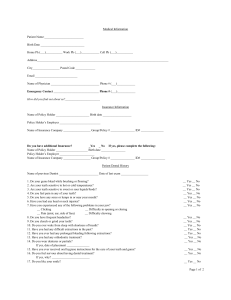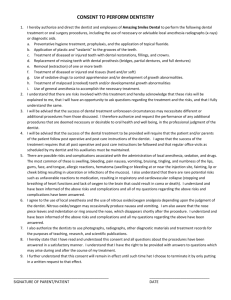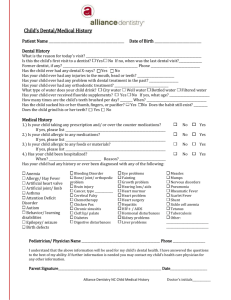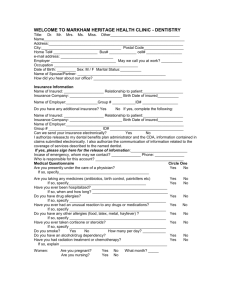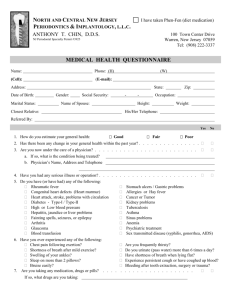Final Report Format Follow-Up Activities to EHS/HS State/Territorial
advertisement
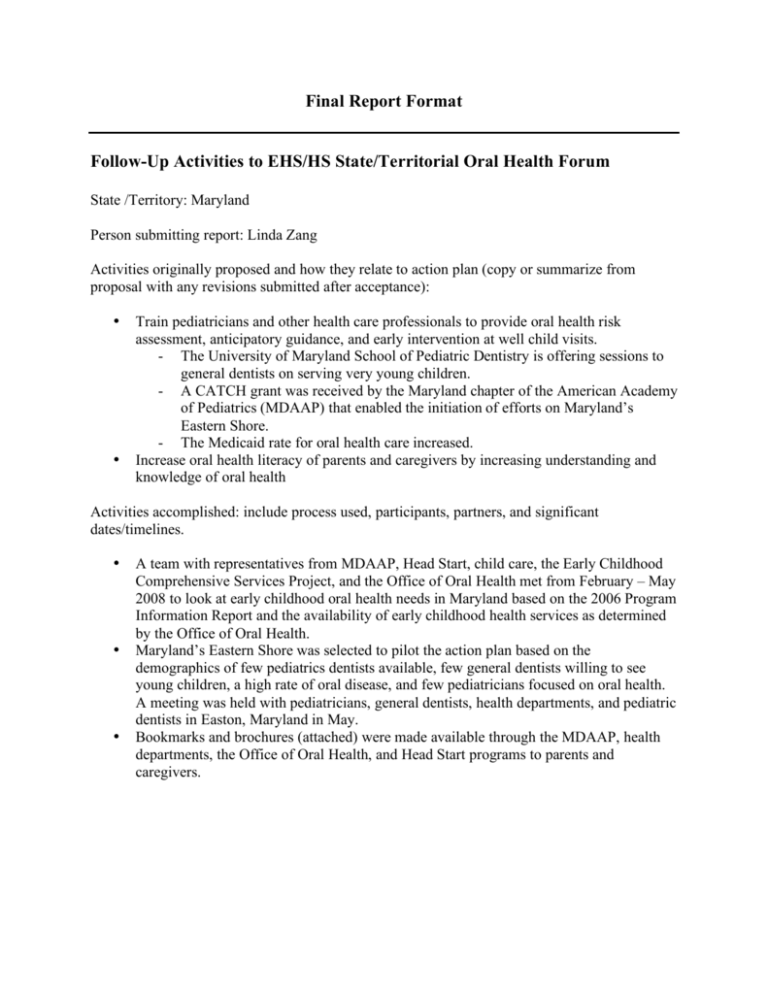
Final Report Format Follow-Up Activities to EHS/HS State/Territorial Oral Health Forum State /Territory: Maryland Person submitting report: Linda Zang Activities originally proposed and how they relate to action plan (copy or summarize from proposal with any revisions submitted after acceptance): • • Train pediatricians and other health care professionals to provide oral health risk assessment, anticipatory guidance, and early intervention at well child visits. - The University of Maryland School of Pediatric Dentistry is offering sessions to general dentists on serving very young children. - A CATCH grant was received by the Maryland chapter of the American Academy of Pediatrics (MDAAP) that enabled the initiation of efforts on Maryland’s Eastern Shore. - The Medicaid rate for oral health care increased. Increase oral health literacy of parents and caregivers by increasing understanding and knowledge of oral health Activities accomplished: include process used, participants, partners, and significant dates/timelines. • • • A team with representatives from MDAAP, Head Start, child care, the Early Childhood Comprehensive Services Project, and the Office of Oral Health met from February – May 2008 to look at early childhood oral health needs in Maryland based on the 2006 Program Information Report and the availability of early childhood health services as determined by the Office of Oral Health. Maryland’s Eastern Shore was selected to pilot the action plan based on the demographics of few pediatrics dentists available, few general dentists willing to see young children, a high rate of oral disease, and few pediatricians focused on oral health. A meeting was held with pediatricians, general dentists, health departments, and pediatric dentists in Easton, Maryland in May. Bookmarks and brochures (attached) were made available through the MDAAP, health departments, the Office of Oral Health, and Head Start programs to parents and caregivers. Immediate outcomes (attach any reports or other documents/materials): • • As the major need identified was for parent education, the materials were highly requested to share with the families. Dentists and pediatricians on the Eastern Shore requested training from the University of Maryland School of Pediatric on oral health and very young children including exams, treatment, fluoride varnish, etc. Additional follow-up activities planned: • • The Office of Oral Health and the University Of Maryland School of Pediatric Dentistry will provide training. The Office of Oral Health will distribute remaining materials Need for additional resources to accomplish other follow-up activities (please be specific) Budget Explanation How ASTDD Funds Were Used To produce parent education materials: Lift the Lip bookmark Oral Health for Young Children brochure Other Funds Expended, Include Source N/A In-Kind Support, Include Source N/A Access to Dental Care for Maryland’s Young Children A Guide for Parents Why is Dental Care Important? • Dental cavities in young children can produce pain and infection, affect speech, and create crooked teeth. Children with tooth pain have problems with learning and growing. • Half of all Head Start children in Maryland have dental cavities. How To Help Prevent Tooth Decay in Your Child • Brush your child’s teeth twice daily with a smear of fluoride toothpaste. • Look for black or brown areas on your child’s teeth when you brush them. These spots could be signs of cavities. • Limit the number of sugary snacks your child eats. These snacks include candy, sweet drinks (juice, soda, milk or tea with sugar) and cookies. Sticky foods such as caramels should be avoided. National Head Start Standards for Dental Care • All Head Start programs provide dental examinations for children. • Head Start is required to refer children with dental problems for dental care and to follow up to see if care has been received. • Children with special health care needs must receive services addressing all health concerns. • Child care programs are not required to follow the Head Start Standards. What to Expect from a Dental Visit The dentist will examine your child’s teeth, which may include taking x-rays. He may clean your child’s teeth and apply fluoride. The dentist will discuss with you any problems that he has found, and will either correct these problems or refer you to someone who will fix them. Parents Need to be a Partner with the Dentist • Talk with your child about the dentist. Explain that the dentist wants to help them take care of their teeth. • Be honest with your child. Let them know what is expected and try to answer their questions as best as you can. The dentist and their staff will also talk with your child to reduce their fears. • Never use the dentist or dental visit as a punishment. • Be positive. Even if you do not like going to the dentist it is important not to share your feelings with your child. • Be on time, and try your best to keep every appointment. If you must cancel an appointment, call the dentist’s office at least two days before What About Dental Insurance? If you do not have your own private dental insurance, your child may qualify for Medicaid or Maryland Children’s Health Program (enrollment hotline: 800-456-8900 CHECK TELEPHONE LINE). If your child is enrolled in Medicaid (HealthChoice) and you need to talk to someone regarding dental care, contact the following agencies: AMERIGROUP Community Care Dental Health Providers 1-800-600-4441 Priority Partners 1-800-654-9728 MedStar Family Choice 1-888-404-3549 or 410-581-0708 The Diamond Plan 1-866-533-5154 Jai Medical Systems 1-888-524-1999 UnitedHealthcare 1-800-318-8821 Maryland Physicians Care 1-800-953-8852 How Early Childhood Staff Can Help Prevent Tooth Decay in Children • Help children brush using a smear of fluoridated toothpaste after eating. • Serve healthy and low sugar snacks. • Limit the frequency that sweets are consumed by children. Even frequent drinking of 100% juice has a lot of natural sugar that can harm teeth. • Remind parents that they also need to brush their child’s teeth and to look for black or brown areas that could be the beginning of a cavity. Healthy Baby Teeth Healthy Baby Teeth Look closely along the gum line for white lines or brown spots on the front or back of teeth. Look closely along the gum line for white lines or brown spots on the front or back of teeth. TO CHECK BABY’S TEETH: ♦ Lift the lip once a month. ♦ Look for early cavities—white lines along the gum line ♦ Never put a baby to bed with a bottle, unless it’s water. ♦ Wean from the bottle by age 12-14 months. ♦ Clean baby’s teeth daily with a soft toothbrush or clean washcloth. TO CHECK BABY’S TEETH: ♦ Lift the lip once a month. ♦ Look for early cavities—white lines along the gum line ♦ Never put a baby to bed with a bottle, unless it’s water. ♦ Wean from the bottle by age 12-14 months. ♦ Clean baby’s teeth daily with a soft toothbrush or clean washcloth. Take your child to the dentist by age one. Take your child to the dentist by age one. Lift the Lip Lift the Lip MILD DECAY Chalky white lines at the gum line May be reversed—See a dentist soon! MILD DECAY Chalky white lines at the gum line May be reversed—See a dentist soon! MODERATE DECAY MODERATE DECAY Looks like teeth are “melting or chipping” See a dentist before decay gets worse. Looks like teeth are “melting or chipping” See a dentist before decay gets worse. SEVERE DECAY Must see a dentist to avoid future damage to permanent teeth. SEVERE DECAY Must see a dentist to avoid future damage to permanent teeth. Brought to you by the Office of Oral Health, Maryland Department of Health and Mental Hygiene under license from the Calgary Health Region™. Brought to you by the Office of Oral Health, Maryland Department of Health and Mental Hygiene under license from the Calgary Health Region™. www.fha.state.md.us/oralhealth 04/08 www.fha.state.md.us/oralhealth 04/08 Dientes Saludables del Niño Dientes Saludables del Niño Busque manchas blancas o marrones adelante y atrás de los dientes. Busque manchas blancas o marrones adelante y atrás de los dientes. REVISAR LOS DIENTES DEL NIÑO: ♦ Levante el labio una vez al mes ♦ Revise la parte de arriba de los dientes, adelante y atrás especialmente cerca de las encías. ♦ Nunca ponga al bebé a dormir con el biberón – a menos que contenga agua. ♦ Retire el biberón cuando el niño tenga 12-14 meses de edad. ♦ Limpie los dientes del niño diario con un cepillo suave o con una toallita todos los días. LLEVE AL NIÑO AL DENTISTA A LA EDAD DE UN AÑO. REVISAR LOS DIENTES DEL NIÑO: ♦ Levante el labio una vez al mes ♦ Revise la parte de arriba de los dientes, adelante y atrás especialmente cerca de las encías. ♦ Jamás ponga al bebé a dormir con el biberón– a menos que contenga agua. ♦ Retire el biberón cuando el bebé tenga 12-14 meses de edad. ♦ Limpie los dientes del niño diario con un cepillo suave o con una toallita todos los días. LLEVE AL NIÑO AL DENTISTA A LA EDAD DE UN AÑO. Levante El Labio Levante El Labio CARIES TEMPRANAS Manchas blancas o café ¡Vea a su dentista en seguida! CARIES TEMPRANAS Manchas blancas o café ¡Vea a su dentista en seguida! CARIES MODERADAS Lleve al niño al dentista antes que las caries sean peores. CARIES MODERADAS Lleve al niño al dentista antes que las caries sean peores. CARIES SEVERAS Debe ver a su dentista para evitar el daño futuro de dientes. CARIES SEVERAS Debe ver a su dentista para evitar el daño futuro de dientes. Brought to you by the Office of Oral Health, Maryland Department of Health and Mental Hygiene under license from the Calgary Health Region™. Brought to you by the Office of Oral Health, Maryland Department of Health and Mental Hygiene under license from the Calgary Health Region™. www.fha.state.md.us/oralhealth 04/08 www.fha.state.md.us/oralhealth 04/08


